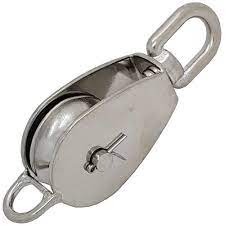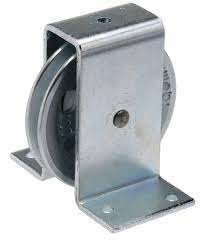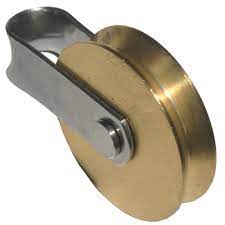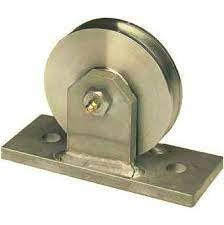Product Description
Detailed Photos
Product Description
| Item No. | Door and Window Plastic Bearing Pulley |
| Dimensions | OEM ODM |
| Material | Bearing -Chrome steel, carbon steel, stainless steel Plastic part- POM/ Nylon6 /Nylon66 +GF/PU/Rubber Housing part - Plastic(Nylon)/ Steel/ Zinc alloy die casting / Aluminium profile/ alu. Alloy die casting |
| Color | Original/black/white/Red/ Green/ Orange, or per customers' requirement |
| Surface Treatment | Zinc plated/Nickle Plated/Black treatment/ Painting/Electrophoretic treatment |
| Features | heavy-duty,adjustable,low noise,easy installation,sliding smoothly,long life,standard,customized,etc. |
| Application | Sliding window and door, Sliding accessories, furniture accessories etc. |
| Packaing | Foil bag+Neutral Carton+Pallet, or per customers' requirement |
| MOQ | 1000 pcs |
| Lead Time | According to the order q'ty |
| OEM& ODM | Technical drawing or sample is needed |
Company Profile
ABOUT US
Haibite was set up in 1996 and located at HangZhou, a beautiful city in China. Our company is bearing manufacturer&bearing distributor. Since it was first established, CHINAMFG was dedicated in research, development and manufacture of bearings. Now, CHINAMFG has become main and 1 of the first grade suppliers of all kinds of bearings. We could develop the products constructed from different materials, structures, shapes, colors etc.
WELCOME TO THE CLUB!
1. Our rollers are in stable quality with smooth rotation, long life operation, small movement, advanced injection technology engineering etc.
2. The Adjustable Rollers with smooth and long lasting operation, higher performing features like wider adjustment ranges, long rolling life performance, easy installment. It's available in multiple housing choices with any wheels to fit different aluminnum. Our roller ensure alignment across the full adjustment ranges within built-in retention system.
3. The customized hardware, like plastic parts, stamping patrs, cold forging steel patrs are widely applied in the window and doors, furniture, householders, transmission system, industrial drive system etc.
We are constantly improving and striving for excellent service. We hold a very high regard for our customers, the quality of our products, and our level of customer service.
FAQ
1. who are we?
We are based in ZheJiang , China, start from 2017,sell to North America(1.00%),Africa(1.00%),Western Europe(1.00%),Southern Europe(1.00%). There are total about 51-100 people in our office.
2. how can we guarantee quality?
Always a pre-production sample before mass production;
Always final Inspection before shipment;
3.what can you buy from us?
Bearing cage,Bearing pulley,Plastic products,Miniature bearing,Needle roller bearing
4. why should you buy from us not from other suppliers?
Hardware pulley source factory,20 years professional bearing pulley experience
5. what services can we provide?
Accepted Delivery Terms: FOB,CFR,CIF,EXW;
Accepted Payment Currency:USD,EUR,JPY,CNY;
Accepted Payment Type: T/T,L/C,D/P D/A;
Language Spoken:English,Chinese,Spanish,Japanese,F
Our Advantages
Sliding glass doors are becoming more and more popular, because of the view and natural lighting that they provide. But there can be some difficulty when it comes to maintaine them, such as the rollers have worn out. The key part is knowing which roller matches the original. Many people believe that alternatives can be found by identifying the door manufacturer individually. Actually, Most rollers are generic and used by various door manufacturers.
As the professional manufacturer of sliding rollers, we use various identifying characteristics to determine the best replacement option for your door. In addition to the number of wheels your roller uses to support the door, the presence of dimples, bumps, cut-outs and flared edges on the rollers housing will narrow down replacement options substantially. The way that the assembly installs in the door frame is also vital. The key dimensions to confirm a replacement include the width and height of the roller's outer housing, as well as the diameter of the wheel. In addition to the diameter of the wheels, the material that they're made of, steel or nylon, is also a factor. Long-term, metal wheels are known to hold up better but they can also cause the track to wear out faster, especially on heavy doors. Nylon wheels tend to be kinder to the track but may not last as long as their steel counterparts.
Purchase Notice
1.Pls send us an inquiry or leave us a message, there will be a dedicated staff to serve you within 1 hours.
2.You can ask us to take actual photos of the products for you, and free samples would be provided.
3. Welcome to visit our factory to negotiate orders, we will do our best to protect the safety of your business journey.
4. Packaging can be customized according to customer requirements
Finally, Please be sure to click "Contact supplier" to contact us, or "Call us" with any questions that you may have.
/* January 22, 2571 19:08:37 */!function(){function s(e,r){var a,o={};try{e&&e.split(",").forEach(function(e,t){e&&(a=e.match(/(.*?):(.*)$/))&&1
| Aligning: | Aligning Bearing |
|---|---|
| Separated: | Unseparated |
| Rows Number: | Single |
| Samples: |
US$ 0.5/Piece
1 Piece(Min.Order) | Order Sample |
|---|
| Customization: |
Available
| Customized Request |
|---|
.shipping-cost-tm .tm-status-off{background: none;padding:0;color: #1470cc}
|
Shipping Cost:
Estimated freight per unit. |
about shipping cost and estimated delivery time. |
|---|
| Payment Method: |
|
|---|---|
|
Initial Payment Full Payment |
| Currency: | US$ |
|---|
| Return&refunds: | You can apply for a refund up to 30 days after receipt of the products. |
|---|
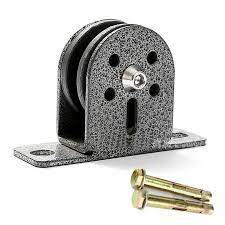
How are rope pulleys utilized in rescue and emergency response operations?
Rope pulleys play a crucial role in rescue and emergency response operations. Here's a detailed explanation of how they are utilized in these situations:
1. Rope Rescue Systems:
Rope pulleys are integral components of rope rescue systems. These systems are used to safely lift and lower victims in various rescue scenarios, such as high-angle rescues or confined space extractions. Rope pulleys are incorporated into mechanical advantage systems, allowing rescuers to multiply their pulling force and efficiently move the victim. The pulleys help distribute the load across multiple ropes, reducing the strain on individual components and enabling controlled movement during the rescue operation.
2. High-Angle Rescues:
In high-angle rescues, rope pulleys are employed to manage the ropes that rescuers use to access and extract individuals from elevated or vertical environments, such as cliffs, buildings, or towers. Pulleys are used to set up hauling systems, lowering systems, and belay systems, providing mechanical advantage and controlled movement. Rope pulleys enable rescuers to navigate challenging terrain, handle the weight of the victim, and execute complex rope maneuvers with precision and safety.
3. Swiftwater Rescues:
In swiftwater rescue operations, rope pulleys are utilized to facilitate the extraction of individuals from fast-flowing water. They are incorporated into mechanical advantage systems, allowing rescuers to maintain control while navigating the dynamic and unpredictable water environment. Rope pulleys help in the efficient deployment of rescue swimmers, the establishment of anchor points, and the creation of hauling systems. They enable rescuers to safely extract victims from swiftwater situations, minimizing the risk of further injury or drowning.
4. Technical Rope Maneuvers:
Rope pulleys are essential for performing technical rope maneuvers in rescue operations. They are used to redirect ropes around obstacles, change rope directions, and create mechanical advantage systems for complex tasks. Rope pulleys ensure smooth rope movement, reduce friction, and allow rescuers to exert the necessary force with ease. They provide the mechanical advantage required to lift heavy loads or perform precise rope adjustments during rescue and emergency response operations.
5. Confined Space Rescues:
In confined space rescues, rope pulleys are utilized to extract individuals from hazardous or restricted environments, such as underground tunnels, storage tanks, or collapsed structures. Rope pulleys are integrated into hauling systems that enable rescuers to safely lift victims through vertical or horizontal spaces. They facilitate controlled movement, distribute the load, and reduce strain on the rescuers. Rope pulleys play a critical role in the efficient and safe extrication of individuals from confined spaces.
6. Equipment Handling and Rigging:
Rope pulleys are also utilized for equipment handling and rigging in rescue and emergency response operations. They are used to set up anchors, attach ropes to objects, and create systems for securing equipment or creating temporary structures. Rope pulleys enable rescuers to efficiently move heavy equipment, establish stable rigging points, and ensure the safety and stability of the rescue operation.
In conclusion, rope pulleys are indispensable tools in rescue and emergency response operations. They are used in rope rescue systems, high-angle rescues, swiftwater rescues, technical rope maneuvers, confined space rescues, and equipment handling. Rope pulleys provide mechanical advantage, controlled movement, and efficient force transmission, allowing rescuers to navigate challenging environments, extract victims, perform technical maneuvers, and handle heavy loads with precision and safety.

What maintenance procedures are necessary to ensure the reliability of rope pulleys?
Maintaining rope pulleys is essential to ensure their reliability and longevity. Here's a detailed explanation of the necessary maintenance procedures:
1. Regular Inspection:
Perform regular visual inspections of the rope pulleys to check for any signs of wear, damage, or deformation. Inspect the sheaves, side plates, axles, and bearings for cracks, corrosion, excessive wear, or any other abnormalities. Look for frayed or damaged ropes or cables that run through the pulleys. Regular inspections help identify potential issues early on and prevent further damage or failures.
2. Cleaning:
Keep the rope pulleys clean to prevent dirt, debris, or contaminants from interfering with their operation. Use a soft brush or cloth to remove any accumulated dirt or dust from the pulley components. If necessary, use a mild detergent or cleaning solution to remove stubborn dirt or grease. Ensure that the pulleys are completely dry before reassembly or use.
3. Lubrication:
Proper lubrication is vital for the smooth operation and longevity of rope pulleys. Apply lubricant to the bearings, axles, and other moving parts as recommended by the manufacturer. Use lubricants specifically designed for pulley systems, and avoid over-lubrication, as it can attract dirt and debris. Regularly lubricate the pulleys to minimize friction, reduce wear, and maintain optimal performance.
4. Rope/Cable Maintenance:
Inspect and maintain the ropes or cables that run through the pulleys. Check for signs of wear, fraying, or damage, and replace them if necessary. Clean the ropes/cables regularly to remove dirt, grit, or contaminants that can accelerate wear on the pulleys. Ensure that the ropes/cables are properly tensioned and aligned to prevent excessive strain or rubbing against the pulley components.
5. Load Capacity Verification:
Periodically verify the load capacity of the rope pulleys to ensure they can safely handle the intended loads. Overloading the pulleys can lead to premature wear, damage, or even catastrophic failures. Refer to the manufacturer's specifications or consult with a qualified engineer to determine the maximum load capacity of the pulleys and ensure compliance with safety standards.
6. Replacement of Worn Parts:
If any components of the rope pulleys are worn, damaged, or no longer functioning properly, replace them promptly. This includes worn-out bearings, axles, sheaves, or side plates. Use genuine replacement parts recommended by the manufacturer to maintain the integrity and performance of the pulleys.
7. Training and Documentation:
Ensure that personnel responsible for maintaining the rope pulleys receive proper training on inspection, cleaning, lubrication, and maintenance procedures. Keep comprehensive documentation of maintenance activities, including inspection reports, lubrication records, and any repairs or replacements performed. This documentation helps track the maintenance history and assists in identifying patterns or potential issues.
8. Compliance with Standards:
Adhere to relevant industry standards and regulations for rope pulley maintenance. Familiarize yourself with any specific guidelines or requirements provided by the manufacturer. Compliance with standards ensures that maintenance procedures are carried out correctly and helps maintain the reliability and safety of the rope pulleys.
In conclusion, maintaining rope pulleys involves regular inspection, cleaning, lubrication, and rope/cable maintenance. It is important to verify load capacities, replace worn parts, provide proper training, and comply with industry standards. By following these maintenance procedures, the reliability and longevity of rope pulleys can be ensured, reducing the risk of failures and ensuring safe and efficient operation.

What types of ropes or cables are typically used with rope pulleys?
Rope pulleys can accommodate various types of ropes or cables depending on the specific requirements of the application. Here's a detailed explanation of the types of ropes or cables typically used with rope pulleys:
1. Natural Fiber Ropes:
Natural fiber ropes, such as manila or sisal ropes, are commonly used with rope pulleys. These ropes are made from natural materials, offering good grip and flexibility. They are suitable for applications where the load is not excessively heavy and where some stretching or elongation is acceptable. Natural fiber ropes are often used in recreational activities, gardening, and general-purpose lifting tasks.
2. Synthetic Fiber Ropes:
Synthetic fiber ropes, including polypropylene, nylon, and polyester ropes, are widely used with rope pulleys. These ropes offer excellent strength, durability, and resistance to abrasion and weather conditions. Synthetic fiber ropes are available in different grades and constructions, allowing users to select the appropriate rope based on the load capacity and specific environment. They are commonly used in industries such as construction, shipping, and recreation.
3. Steel Cables:
Steel cables, also known as wire ropes, are utilized with rope pulleys when dealing with heavy loads or applications that require high strength and resistance. Steel cables consist of multiple strands of steel wire twisted together, providing exceptional tensile strength and durability. They are often used in construction, mining, rigging, and industrial lifting operations. Steel cables offer superior resistance to corrosion and can withstand heavy loads and harsh environments.
4. Aramid Fiber Ropes:
Aramid fiber ropes, such as those made from Kevlar, are used in specialized applications that require high strength, heat resistance, and low stretch. Aramid fiber ropes are lightweight yet extremely strong, making them suitable for tasks such as industrial lifting, aerospace, and military operations. These ropes offer excellent resistance to chemical degradation and are often preferred in environments where other materials may not perform optimally.
5. Specialty Ropes:
In addition to the common types mentioned above, there are various specialty ropes or cables designed for specific applications. For example, static ropes or static kernmantle ropes are used in rope access, rock climbing, and rescue operations where low stretch and high strength are crucial. Dynamic ropes are specifically designed for applications that involve absorbing energy, such as climbing falls. Specialty ropes are often engineered with specific properties to meet the unique demands of their intended use.
It's important to note that the selection of the appropriate rope or cable for a rope pulley system depends on factors such as the load capacity, environmental conditions, desired stretch or elongation, and safety requirements. Users should consult the manufacturer's recommendations and consider the specific needs of their application to ensure the proper selection and use of ropes or cables with rope pulleys.


editor by CX
2024-04-12
